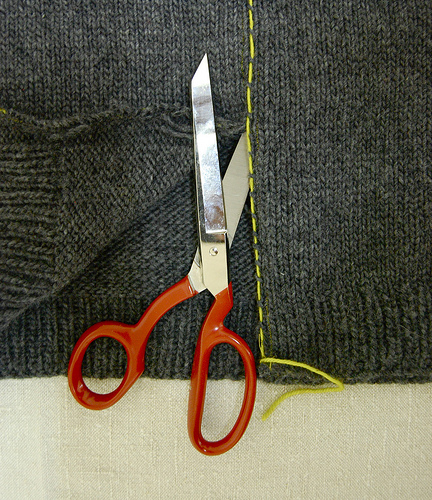Steeking: A wonderful and terrifying knitting technique

A few weeks ago I stopped in at Apple Yarns in Bellingham just in time to witness a steeking demonstration. Steeking is never not terrifying, even when - as was the case this time - a seasoned knitter is surrounded by other seasoned knitters all offering encouraging words and technical advice. There's just something terrifying about taking a pair of scissors to something you have just finished knitting.
The best advice about steeking is to embrace the terror. Understand it, accept it, and move forward. Even seasoned steekers feel a thrill of fear whenever they start to cut their knitting in half. It's a daredevil move, and yet it works perfectly well.
Steeking is the term for cutting your knitting in half, or cutting a big slit in your knitting. The most common use of steeking is to turn what would otherwise be a pullover sweater into a cardigan. Such was the case with the demo I witnessed. The knitter had finished this adorable baby sweater, which she knit in the round. Now she was ready to cut it in half and add a button band.
Why knit your work in the round and then cut it in half? Two words: stranded colorwork. If you have ever tried to work stranded colorwork back and forth, you will certainly wish you hadn't. It's so much easier to work stranded colorwork in the round, then cut it in half to make a cardigan.
If you use a "sticky" yarn, like a traditional Shetland or Lopi wool yarns, you barely need to do anything. The wool will felt back on itself and hold the edge marvelously. But if you are using a more slippery yarn, or if you just want extra reassurance (who wouldn't?) you can sew or crochet a line up on either side before you make your cut.
Here are some great steeking tutorials, and be brave!
Image courtesy Flickr/hyena-in-petticoats

0 comments